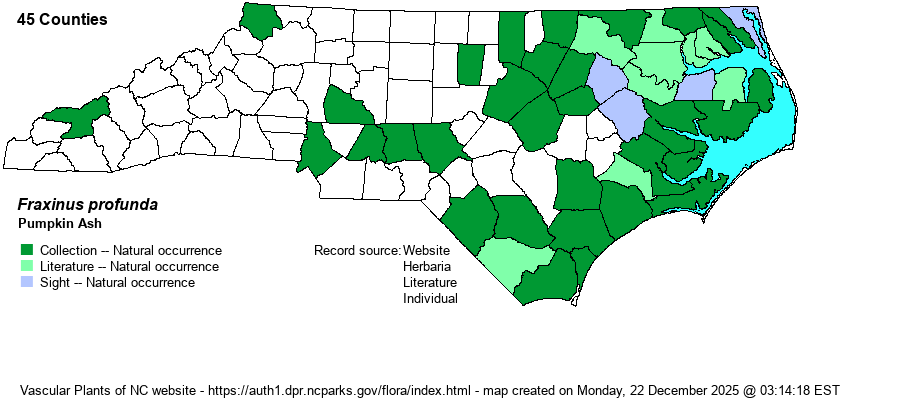| Author | (Bush) Bush | |
| Distribution | Quite spotty and a bit peculiar in range, being scattered over the Coastal Plain but scarce in many places (such as the Sandhills). Rare and local in the eastern Piedmont, with a few records (correct?) from the central Piedmont. Very rare in the Mountains, where specimen records exist for Ashe and Swain counties (if correct).
A strangely bimodal range, being found in narrow north-south bands from southern NJ south to FL (essentially in the Coastal Plain), then another band from northwestern PA and southern MI south to LA. It is scarce to absent from the Piedmont and mountain regions, yet it ranges far to the north in the Ohio and lower Mississippi drainages.
| |
| Abundance | Generally uncommon to locally fairly common in the Coastal Plain, but is mysteriously rare to absent from some swampy regions where it ought to be present. Much less numerous than Carolina (F. caroliniana) and Green (F. pennsylvanica) ashes in wetlands in this province. Rare and local in the eastern Piedmont, and absent to very rare in the western half of the state. Though declines due to emerald ash borer have perhaps not been noted in this species yet, the NCNHP moved the State Rank from S4 to now S3S4 and placed it on its Watch List as W5 -- strongly declining. | |
| Habitat | This species is found mainly growing in shallow standing water of swamps, ranging from tidal swamps to more inland ones, and may be found in both brownwater and blackwater sites. At most sites, it is normally found growing with -- and is much less numerous than – Bald Cypress (Taxodium distichum) and the two gums, Water Tupelo (Nyssa aquatica) and Swamp Tupelo (N. biflora). It is scarce in bottomlands or other sites that are not regularly flooded, as well as in strongly acidic wetlands in the Sandhills. |
| Phenology | Flowers in April and May, and fruits from August to October. | |
| Identification | This ash is easily overlooked or is poorly known by many if not most biologists, as it can be local and it may require a canoe, binoculars, rubber boots, etc., to see it well. It is a medium to tall deciduous tree, mostly to about 80 feet tall, rarely to 100 feet tall. It has the rather typical 7-9 elliptical to lanceolate leaflets like other ashes, each 4-5 inches long. However, the bases of the leaflets are rounded to nearly squared, and thus the petiole is well exposed and distinct from the blade of the leaflet. Other ashes have more tapered leaflets such that they usually appear sessile. The twigs, petioles, and rachises are densely hairy, which will separate it from several other ash species, but note that one form of Green Ash also has similar hairy parts. The samaras are the largest of all our ashes, being at least 2 inches long and quite wide, to about 9 mm (1/3-inch) wide, and the wings extend past the body to reach the base; most others have very narrow samaras with the wings not extending past the body. As with most trees that routinely grow in standing water – such as cypresses and Water Tupelo – this ash typically shows an enlarged or buttressed trunk near the waterline. This is normally not seen in Green Ash, which is more of a bottomland species or grows more often in swamps that are less frequently flooded. | |
| Taxonomic Comments | Many or most older references, including RAB (1968), named the species as F. tomentosa.
| |
| Other Common Name(s) | Red Ash (confusing, as F. pennsylvanica is at times called Red Ash) | |
| State Rank | S3S4 | |
| Global Rank | G4 | |
| State Status | W5 | |
| US Status | | |
| USACE-agcp | OBL link |
| USACE-emp | OBL link |

